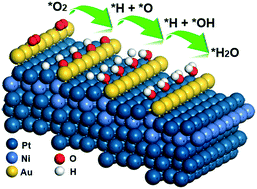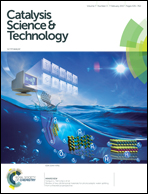Promoting the oxygen reduction reaction with gold at step/edge sites of Ni@AuPt core–shell nanoparticles†
Abstract
Adding gold as the third element forming ternary Pt-based core–shell nanoparticles (NPs) is an efficient strategy for enhancing the durability of the cathode during the oxygen reduction reaction (ORR). Herein, using high-index (221) facets as a model catalyst, we discovered from density functional theory calculations that the inert Au atoms localized at the surface edge sites of Pt-based NPs can effectively promote the elementary steps of the ORR. Our results show that at the working potential (U = 0.8 V), the ORR at step/edges sites on Ni@AuPt core–shell NPs is kinetically much more facile than on pure Pt NPs, and the rate-determining step is likely to be O2 protonation forming *OOH against *O protonation forming *OH on Pt NPs. We identified that the surface activity of Pt atoms of core–shell NPs can be well explained by either the d-band model or the coordination-number model, which have the same chemical nature origin. Our study provides a fundamental understanding of functionality of step/edge sites of Pt-based core–shell NPs for the ORR, which can be used for engineering practical cathode catalysts with atomic efficiency and precision by maximizing the occupancy of gold atoms at edge sites.

- This article is part of the themed collection: 2017 Catalysis Science & Technology HOT Articles


 Please wait while we load your content...
Please wait while we load your content...